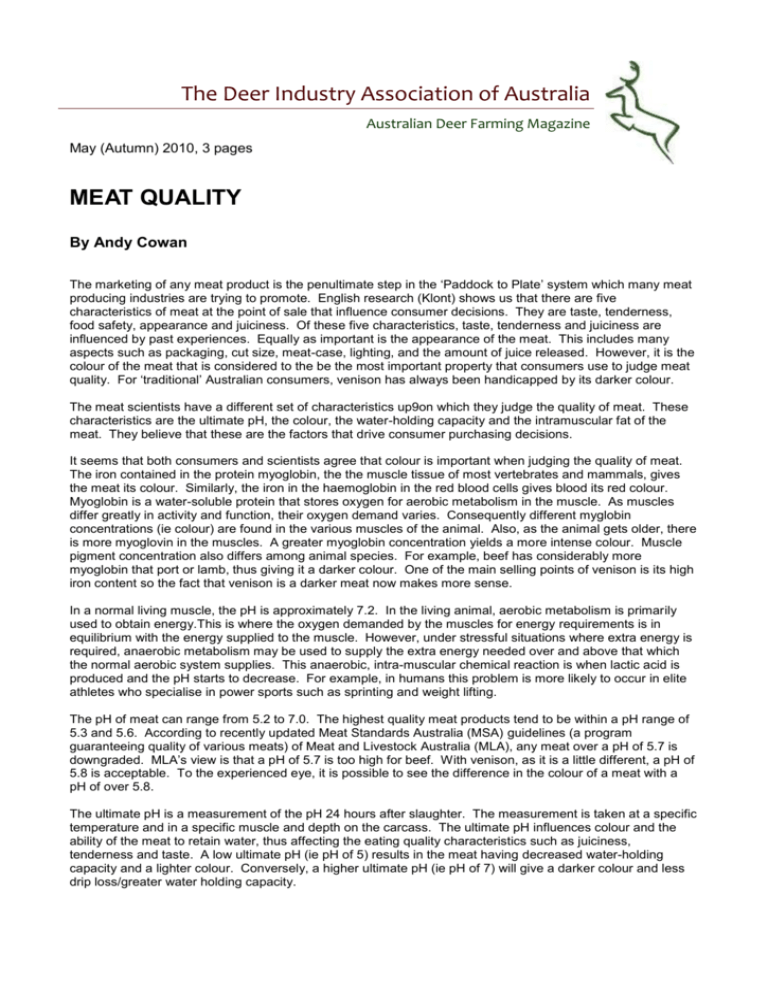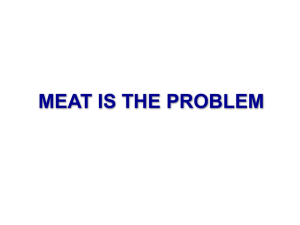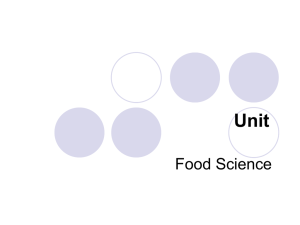85-May-10-Meat_Quality - Deer Industry Association of Australia
advertisement

The Deer Industry Association of Australia Australian Deer Farming Magazine May (Autumn) 2010, 3 pages MEAT QUALITY By Andy Cowan The marketing of any meat product is the penultimate step in the ‘Paddock to Plate’ system which many meat producing industries are trying to promote. English research (Klont) shows us that there are five characteristics of meat at the point of sale that influence consumer decisions. They are taste, tenderness, food safety, appearance and juiciness. Of these five characteristics, taste, tenderness and juiciness are influenced by past experiences. Equally as important is the appearance of the meat. This includes many aspects such as packaging, cut size, meat-case, lighting, and the amount of juice released. However, it is the colour of the meat that is considered to the be the most important property that consumers use to judge meat quality. For ‘traditional’ Australian consumers, venison has always been handicapped by its darker colour. The meat scientists have a different set of characteristics up9on which they judge the quality of meat. These characteristics are the ultimate pH, the colour, the water-holding capacity and the intramuscular fat of the meat. They believe that these are the factors that drive consumer purchasing decisions. It seems that both consumers and scientists agree that colour is important when judging the quality of meat. The iron contained in the protein myoglobin, the the muscle tissue of most vertebrates and mammals, gives the meat its colour. Similarly, the iron in the haemoglobin in the red blood cells gives blood its red colour. Myoglobin is a water-soluble protein that stores oxygen for aerobic metabolism in the muscle. As muscles differ greatly in activity and function, their oxygen demand varies. Consequently different myglobin concentrations (ie colour) are found in the various muscles of the animal. Also, as the animal gets older, there is more myoglovin in the muscles. A greater myoglobin concentration yields a more intense colour. Muscle pigment concentration also differs among animal species. For example, beef has considerably more myoglobin that port or lamb, thus giving it a darker colour. One of the main selling points of venison is its high iron content so the fact that venison is a darker meat now makes more sense. In a normal living muscle, the pH is approximately 7.2. In the living animal, aerobic metabolism is primarily used to obtain energy.This is where the oxygen demanded by the muscles for energy requirements is in equilibrium with the energy supplied to the muscle. However, under stressful situations where extra energy is required, anaerobic metabolism may be used to supply the extra energy needed over and above that which the normal aerobic system supplies. This anaerobic, intra-muscular chemical reaction is when lactic acid is produced and the pH starts to decrease. For example, in humans this problem is more likely to occur in elite athletes who specialise in power sports such as sprinting and weight lifting. The pH of meat can range from 5.2 to 7.0. The highest quality meat products tend to be within a pH range of 5.3 and 5.6. According to recently updated Meat Standards Australia (MSA) guidelines (a program guaranteeing quality of various meats) of Meat and Livestock Australia (MLA), any meat over a pH of 5.7 is downgraded. MLA’s view is that a pH of 5.7 is too high for beef. With venison, as it is a little different, a pH of 5.8 is acceptable. To the experienced eye, it is possible to see the difference in the colour of a meat with a pH of over 5.8. The ultimate pH is a measurement of the pH 24 hours after slaughter. The measurement is taken at a specific temperature and in a specific muscle and depth on the carcass. The ultimate pH influences colour and the ability of the meat to retain water, thus affecting the eating quality characteristics such as juiciness, tenderness and taste. A low ultimate pH (ie pH of 5) results in the meat having decreased water-holding capacity and a lighter colour. Conversely, a higher ultimate pH (ie pH of 7) will give a darker colour and less drip loss/greater water holding capacity. The pH value is critical for meat marketers. An ultimate pH of less than 5 and greater than 6.5 will lead to a less saleable product. This is due to colour and either reduced or increased water-holding capacity that affect the production processes of fresh meat and/or cooked products. More juice in the prepared meat will give a juicier, more succulent and tender eating experience. Too much juice retained in a high pH meat will cause the smell to be unpleasant when cooking and also the meat will tend to boil on the outside rather than cook evenly throughout. The experience of Mandagery Creek Vension’s Tim Hansen in the marketing of venison over many years has shown that the best Testing pH venison, whether it is for storing for long periods or for immediate consumption, can be stored at a slightly higher pH than other meats. Venison to be sold on the domestic market ranges from a pH of 5.4 to 5.8. Venison that has a pH of 5.8 or more will be frozen. When the meat is frozen the chemical reactions cease and. Although the meat is a little darker, the taste and smell are fine. There is a curve which outlines the relationship between time after slaughter and pH. Normally, after slaughter, the animal is bled – a process known as exsanguination. The muscle pH decreases when an animal is bled because the oxygen is no longer available to the muscle cells and aerobic metabolism begins to fail. To maintain homeostatis (maintaining the constant, balanced condition of the muscles), anaerobic energy metabolism starts and produces lactic acid (more correctly lactate). In the exsanguinated animal, as the circulatory system is not capable of removing the products of this metabolism, the lactic acid remains in the muscle thus lowering the pH. As you would expect, not all animals slaughtered have the same rate of pH decrease. The increasing acidity of the ageing carcass varies in its speed, depending on a number of factors such as the type of animal, the breed, the temperament, the body condition of the animal and the treatment of the animal prior to slaughter. Beef normally reaches its lowest pH value of 5.4 to 5.7 at 18-24 hours after slaughter. After the lowest pH level is reached, the pH starts to rise again – slowly but steadily. By the time it reaches a pH of 6.5, it is starting to decompose. In some animals, muscle pH drops rapidly below 5.8 during the first hours after exsanguinations and then slowly to the ultimate pH. In other animals, the pH drops only slightly during the first hour after slaughter and then remains stable at a relatively high level, giving an ultimate pH of higher than 6.0. Also, the drop in pH and the ultimate pH of muscles will be different depending on the type of muscle within a particular carcass. The rate of pH change post mortem has a large influence on meat quality. Importantly, it must be remembered that consistent measuring techniques must always be adhered to – site, temperature and time. The pH value of meat is important as it provides an idea as to how long it will keep and the technical processing characteristics that can be expected in the future. A high pH encourages microbial meat spoilage whereas a low pH prevents or retards microbial growth. The development of a low pH (acid) in the muscle causes denaturation (loss of structure) of muscle proteins. This denaturation causes a loss of protein solubility, loss of water and a loss of intensity of muscle pigment colouration. All these changes are undesirable, whether the muscle is going to be used as fresh meat or subjected to further processing. So what can farmers do to improve their returns on a carcass? The pictures on the page below may tell a bit of the story. The ages of the animals are inknown but there may be a few clues as to why Farmer B is making less per acre than he could be. Farmer A’s animals (also on the cover) have a Carcass Condition Score (CCS) of 3, a pH range of 5.45 – 5.76 which is acceptable to go into a chilled market. Farmer B’s animals had a CCS of 2 and a pH of 6.1. This will produce a darker meat which may be more difficult to cook well. When animals come to the abattoirs with a CCS less than 2, it will stress more and this will result in a higher pH reading. By supplying the venison vendor with animals which have so much bruising (and this lowering the returns for everyone in the chain) is a situation which can be rectified in a number of ways. Briefly these include better stock management on the farm and better transport facilities. First, the animals have to be well fed. Secondly, if you have naturally quiet deer you may only have to handle the animals as little as three times a year. If the animals are ‘more flighty’ they should be handled more frequently – at least until they do not get nervous running into and being worked in the yards. Also, animals being held in the yards prior to transport to the abattoirs, will quieten down substantially if a mist of water can be sprayed over them for 20-30 minutes. This quietens them down for the oncoming trip as well. The final point which should be made, in order to reduce bruising and stress on the trip to the abattoirs, is hire a truck with a driver who knows how to handle deer! On a number of occasions, when I have had to hire trucks where the driver has had no experience with deer, I have gone to the abattoirs myself with the truck or driven there myself, to do the unloading. Farmer A Farmer B References 1. Ronald Klont. Influence of Ultimate pH on Meat Quality and Consumer Purchasing Decisions. 2. Jane Ann Boles and Ronald Pegg. Meat Colour. Montana State University and Saskatchewan Food Product Innovation Program, University of Saskatchewan. 3. Tim Hansen. Mandagery Creek Venison. Personal communications. 4. Pictures all supplied by Mandagery Creek Venison. © DIAA Article 2010/85








